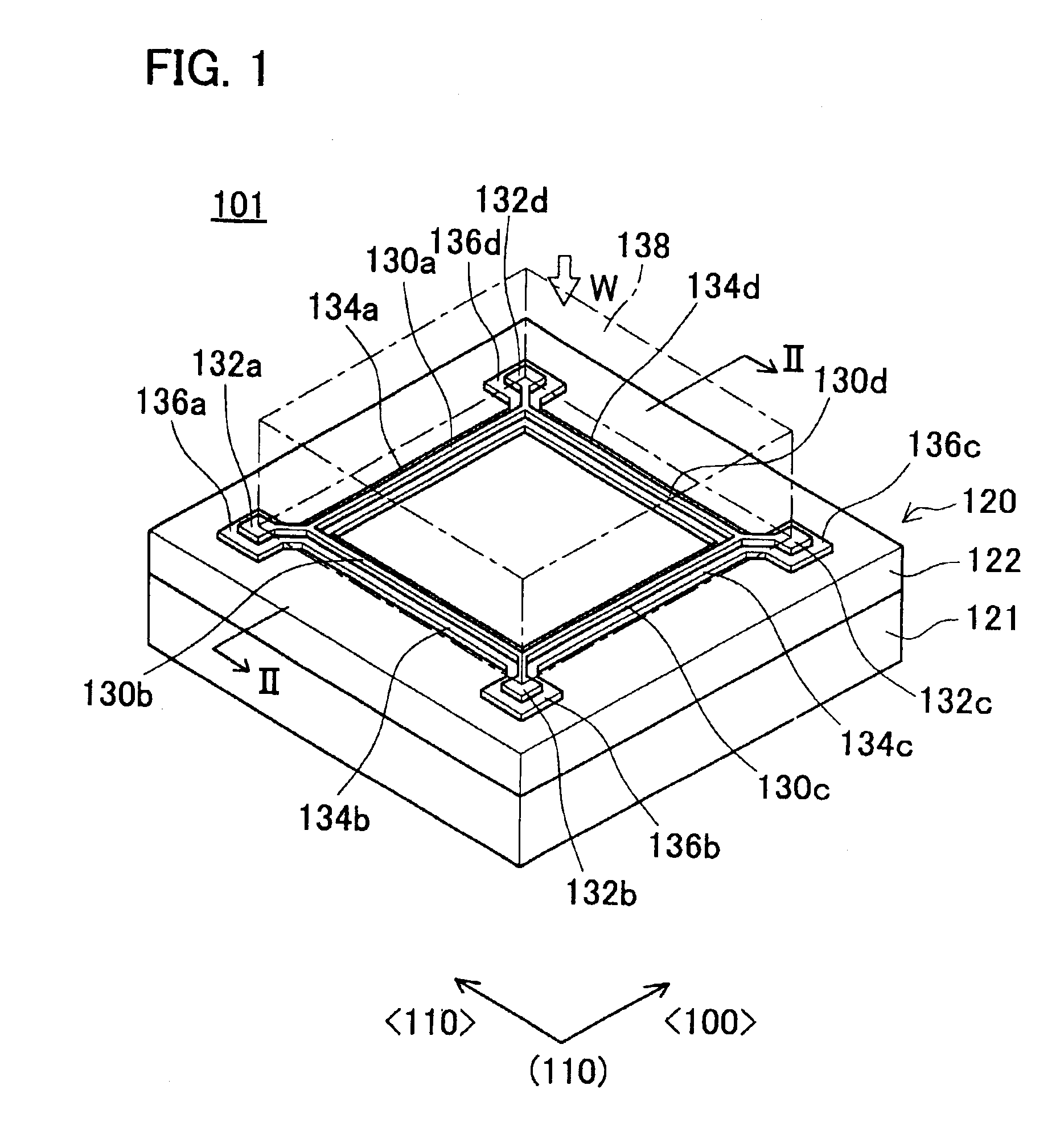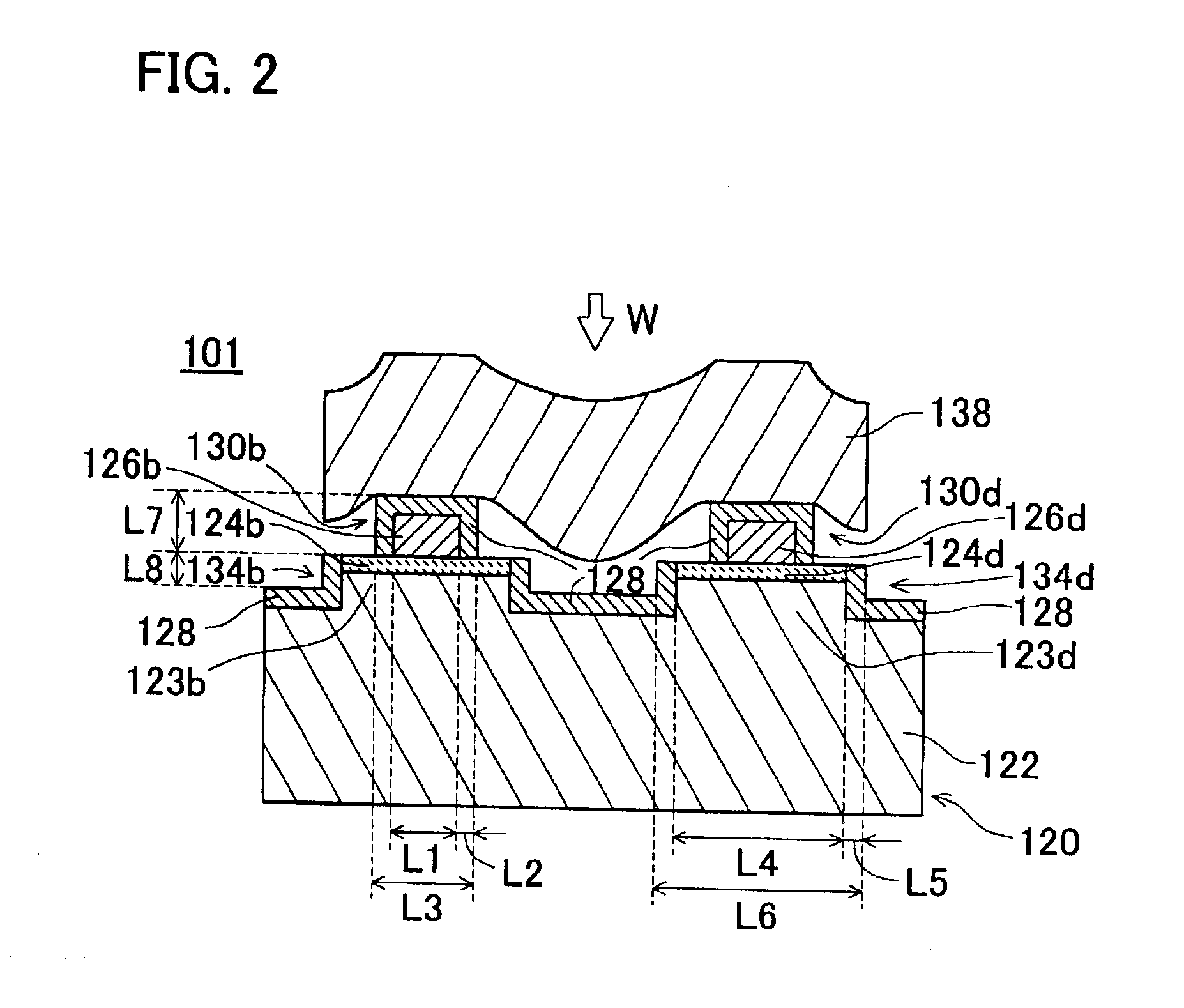Piezoresistive transducers
a technology of resistive transducers and resistive materials, applied in the direction of piezo-resistive material force measurement, force measurement devices, instruments, etc., can solve the problems of current leakage of strain gage from known force detecting devices, and achieve low fluctuation of detection sensitivities, high detection sensitivity, and increased measurement sensitivity
- Summary
- Abstract
- Description
- Claims
- Application Information
AI Technical Summary
Benefits of technology
Problems solved by technology
Method used
Image
Examples
first representative embodiment
[0055]FIG. 1 shows a perspective view of a first representative force detection device (piezoresistive transducer) 101 and FIG. 2 is a cross sectional view of FIG. 1 taken along the line II—II. As shown in FIG. 1, the force detection device 101 comprises a support platform 121, a force detection block 120 and a force transmission block 138. For the sake of clarity, the force transmission block 138 is represented with dashed lines in FIG. 1.
[0056]The support platform 121 may be solid with a substantially square top surface having a width (the length of one side of the square) of about 1.4 mm and a height of about 0.5 mm. The force detection block 120 may be affixed to the upper square surface of the support platform 121.
[0057]The force detection block 120 may be formed using commercially available SOI substrates (i.e., silicon on insulator substrates) or similar materials. The force detection block 120 may include four lower and wider bases 134a, 134b, 134c, 134d that project from a ...
second representative embodiment
[0084]FIG. 8 is a cross sectional view of a second representative force detection device (piezoresistive transducer) 201, which cross sectional view corresponds to the cross sectional view shown in FIG. 2. As shown in FIG. 8, the second representative force detection device 201 includes a force detection block 220 and a force transmission block 238. Ridges 230b, 230d project from the top surface of the force detection block 220. Legs 239 extend from the bottom surface of the force transmission block 238. Although not shown in the drawings, four ridges 230a, 230b, 230c, 230d preferably form a square on the top surface of the force detection block 220. Further, four legs 239a, 239b, 239c, 239d preferably form a square having the same size on the bottom surface of the force transmission block 238. The top faces of the ridges 230 may be adhered or affixed to the bottom surfaces of the legs 239, similar to the first representative embodiment discussed above.
[0085]Each ridge 230b, 230d ma...
third representative embodiment
[0089]FIG. 9 is a perspective view of a third representative force detection device (piezoresistive transducer) 301 and FIG. 10 shows a cross sectional view taken along line X—X shown in FIG. 9. As discussed above, the first representative force detection device 101 shown in FIG. 1 defines a Wheatstone bridge using the four first semiconductor layers 126a-126d. In contrast, the third representative force detection device 301 shown in FIGS. 9 and 10 has a relatively simple strain gage construction using a single first semiconductor layer 326.
[0090]Referring to FIG. 9, the force detection device 301 may include a support platform 321, a force detection block 320 and a force transmission block 338. A lower and wider base 334 may project from the main surface of the force detection block 320. First electrode bases 336a, 336b may be connected to the lower and wider base 334. First upper and narrower ridge 330 may project above the lower and wider base 334. Further, electrodes 332a, 332b ...
PUM
| Property | Measurement | Unit |
|---|---|---|
| height | aaaaa | aaaaa |
| height | aaaaa | aaaaa |
| height | aaaaa | aaaaa |
Abstract
Description
Claims
Application Information
 Login to View More
Login to View More - R&D
- Intellectual Property
- Life Sciences
- Materials
- Tech Scout
- Unparalleled Data Quality
- Higher Quality Content
- 60% Fewer Hallucinations
Browse by: Latest US Patents, China's latest patents, Technical Efficacy Thesaurus, Application Domain, Technology Topic, Popular Technical Reports.
© 2025 PatSnap. All rights reserved.Legal|Privacy policy|Modern Slavery Act Transparency Statement|Sitemap|About US| Contact US: help@patsnap.com



